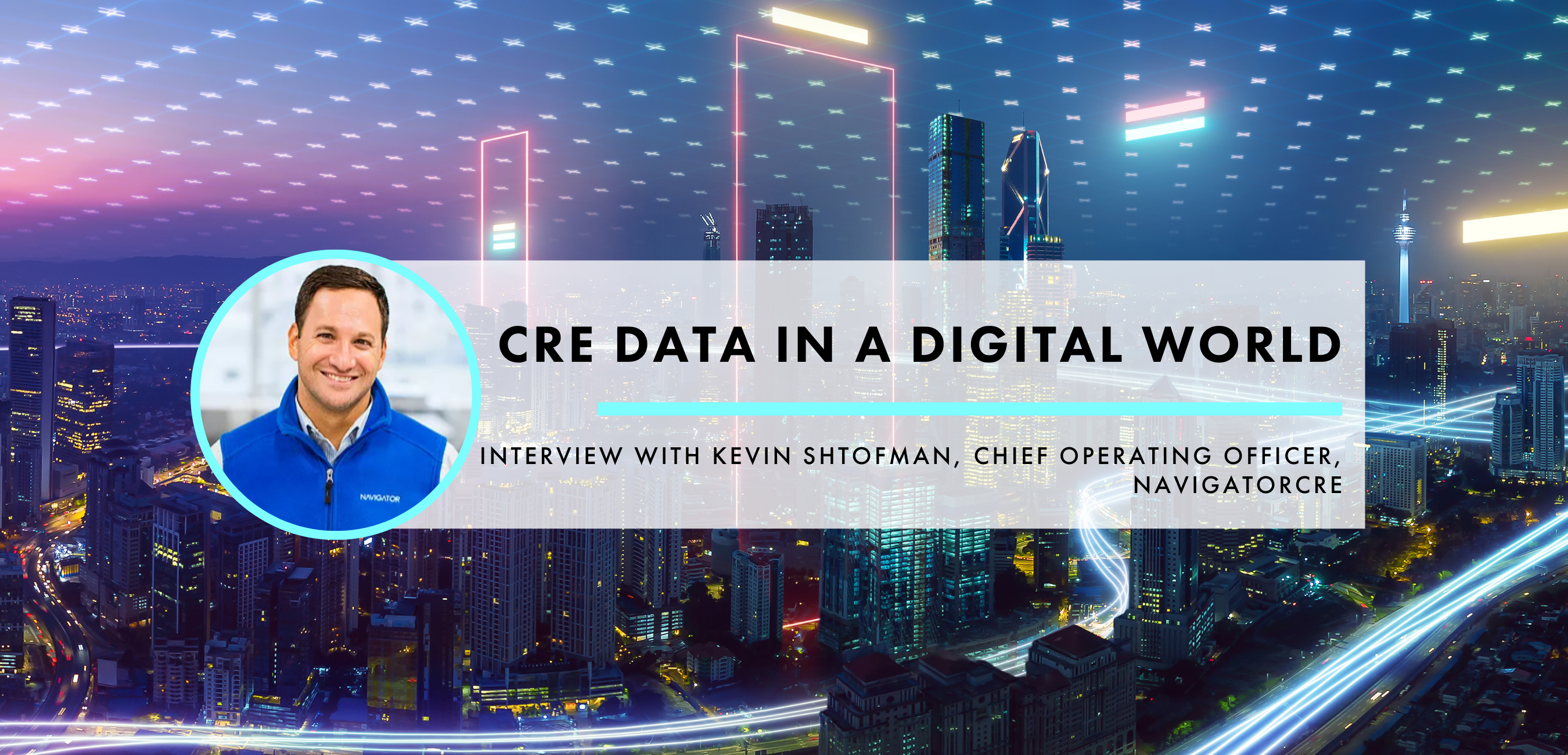CRE Data in a Digital World.
As the Chief Operating Officer at NavigatorCRE, Kevin Shtofman is an industry leader and expert on technology for the built environment. We spoke to Kevin about how the commercial real estate industry can wield data in the digital age. Check out our interview below:
FuturePlace: You started your career as an investment banker, what motivated you to transition into commercial real estate?
Kevin Shtofman: Well, most of the transactions that we were working on were commercial real estate. So I got exposure to the industry. And there’s tons of industries that you can look at and see the product or the output. But not all of them are, as you know, fanciful or amazing. As commercial real estate, it’s very easy to see the result of work in the built world, and so I’ve always been attracted to it.
FP: Why do you dedicate so much of your time evangelizing the value of technology in the built environment?
KS: I think part of it is just because real estate’s been… not against using technology but slow in implementing it.
Ever since the financial crisis, if you had any money, there wasn’t a lot of incentive to implement technology. If you had dry powder, you could take advantage merely by financial engineering and that changed more recently with compressing cap rates and increasing interest rates. Tenants wanted more information and they wanted it more quickly. Investors in limited partner capacities wanted more information more quickly, and employees wanted access to more information more quickly. So, there was this, you know, melding of events in time that led more people to want access to more information faster. And technology enables that because with integrated information, we are all able to make more educated decisions in how we live, how we work, how we play. Real estate impacts all of our lives, whether we’re in the business or not. And so I think technology can play a huge part in making our lives in that business better.
FP: In June of 2019, People Newspapers asked what you saw yourself doing ten years from that very moment. You answered that you envisioned yourself running a company in the real estate sector at the executive level. How did you feel when you became the COO of NavigatorCRE just four months later?
KS: First life changes quickly. Yeah, part of it I think was imposter syndrome. The reason why I said it would be ten years in that interview was because I wasn’t sure I was prepared to be an executive at a large real estate enterprise. At the time, I was thinking of a more established name, like one of NavigatorCRE’s clients now, and that was the goal. When I met the team at Navigator, I was just so impressed by the technology and I thought the timing was perfect. I thought it was worth taking a risk and going from, you know, employee number 10,000 to employee number 10.
FP: You’ve said in an interview that NavigatorCRE was created to augment accelerated decision-making at the executive level. How does your leadership enable companies to act faster?
KS: In my pre-NavigatorCRE experience, I was working with larger institutions within the world of real estate. Investors, owners, operators, managers, advisors, even occupiers. And by their large nature, they were like tanks, not speedboats. They were harder to maneuver and less agile. Any time an executive would ask a question, that question wouldn’t typically be immediately answered in the meeting. That question would then spark a bunch of other questions. And then that cascaded into a series of other meetings that involved a sudden large team of people who would go off and scurry about and then try to answer those questions. Ultimately that delayed the momentum with which these companies could act.
So, I thought for many years about how we could accelerate decisions on whether to acquire another company, whether to move into a new geographic market, whether to change the makeup of a portfolio, or whether to go raise capital from a new limited partner that might request changes to the fund mandate. These were all really big, important, strategic enterprise value-driving decisions. And if that decision took four months to answer instead of 10 minutes to write, by the time you answer the question, market dynamics might have changed already.
Quality and security became a driving force, I think, behind most successful real estate companies are attempts to unlock that without having to hire a team of 15 people whose sole purpose is that decision spending months or years and millions of dollars to build an infrastructure that would accelerate decision making at the executive level. NavigatorCRE attempts to do that in weeks instead of years.
FP: Is there a form of data that you see real estate professionals overlook when they really shouldn’t?
KS: That’s a good question. I think a lot of companies decide they’re in a particular business and they ignore more data that affects a different part of the business. This may look like a ground-up developer who’s only going after land and may not be looking at market data or comparables for buildings that are already built. You know, sales comps or lease comps, because they’re not acquiring these existing buildings. They’re acquiring land, and they should, because eventually they’re going to build that building and then lease it up. And they need to know the likely range of potential lease rates, even if they have the building pre-leased by a single tenant, because the market can shift and potential tenants can change their strategy.
The same happens on the opposite side, folks that don’t do any development themselves and they just buy existing buildings. They often don’t care about land information, and they should because that will help them understand what other new supply might be coming into the market that will either complement or compete with the buildings that they own in that same area. And on the flip side of that, a couple of clients get really excited about some data they think is going to be highly helpful and thus far hasn’t been.
One of the big ones that comes to mind is weather data. If you live in the Gulf of Mexico or Hurricane Alley and you’re trying to analyze like insurance premium data and the odds of a weather event, that sounds like it could be interesting, but thus far, we haven’t seen that really turn into different rental rates or different sales for land rates or things that you would think would drive value. And we haven’t recommended that clients invest a lot of money in that type of data until and unless they’re partnering with insurance companies where understanding that data would then drive insurance premiums or claim payouts or stuff like that.
FP: Why is visualization so important in data processes?
KS: So many of the largest financial institutions and operators, publicly traded REITs, and companies that we work with have the necessary data already to make these important decisions. It’s just spread out in a bunch of different places, right? Some on premise systems, someone’s private spreadsheet or folder structure in their computer, some disparate cloud based systems that only a few people have access to. It’s all over the place. And if all you did was put all that data into one big repository of a big spreadsheet or information profile, it would still take a bunch of expertise and tribal knowledge and context to get to the answers I just previously mentioned, right? When to blend and extend the lease, when to go after somebody for aged receivables and collections, when to update the amenity mix in the building, and when to glean what all of those mean. If you took all of that data and visualized it in such a way that you go onto a screen, a map, a cloud-based grid, a picture-perfect report, or a dashboard where you can just make that decision by looking at it, an insane, almost incalculable level of ROI can be realized. That’s why we think visualization is so important. And in order to do that, you really need to know the real estate business. It’s not good enough to just have data. You have to be a data scientist that has particular knowledge with the ground-up construction, acquisition, lease up, or operations of a multifamily building or an industrial warehouse or retail facility.
FP: What does your distilled explanation for “Big Data” sound like?
KS: I almost hate the phrase “Big Data” because it means so many things to so many different people. As it specifically pertains to real estate, it just means any piece of information that can allow an owner, operator, manager, or occupier of real estate make better decisions with how they interact with the buildings they live or work or play in, and so that’s going to mean a lot of different things to a lot of people.
But, you know, for occupiers, it’s a series of questions. How much space do I really need and how do I need to optimize that space to give my employees excitement and incentive to actually come into the office? When it comes to retail, how do I attract shoppers when they could just go online for most
purchases? How does that shopping visit become more experiential and purposeful? For multifamily owners, how can we encourage more of a community after two and a half years of people really isolating themselves? How do we bring them back and help them socialize with people who they might not have seen that often? They happen to live very, very closely and share common space with you.
FP: You’ve said that data by itself has no inherent value and that more data doesn’t necessarily mean more value. If that’s the case, then why is data such a huge determiner of success in the commercial real estate industry?
KS: Think of data as an ingredient that goes into a recipe. That ingredient is worth very little on its own, but when you combine ingredients together, you end up creating this dish that’s often super enjoyable and, in some cases, even healthy. It’s the same with byproducts for infrastructure. When you pull sludge out of the ground, it’s worthless. But when you refine it, all of a sudden it’s now powering automobiles and power plants. It’s the same in the world of real estate. One data point alone is not going to give you enough of a story. In fact, it might lead you astray, but when you combine multiple data points together, it’s that combination that unlocks value. Whether that is for acquisitions or leasing or treasury management or development across a variety of property types in all geographies, that combination is where the value is fantastic.
Data & Analytics in Real Estate Summit
NavigatorCRE is proudly sponsoring the Data & Analytics in Real Estate Summit, taking place on 21 September 2022.
The Data & Analytics in Real Estate Summit explores how the analytics function can be fully leveraged to provide critical insights that drive strategy and performance. We identify the challenges faced by the commercial team in sourcing suitable data; How to effectively work with data services, and; How new analytics tools and strategies can show the path to alpha profits across your property portfolio and operations. Our focus is on helping the commercial team hunt for operational and portfolio alpha insights – using data science tools that discover hidden opportunities.
Connect with 200+ digital and analytics executives as they share experiences of using analytics tools and strategies.






